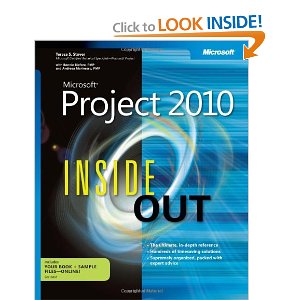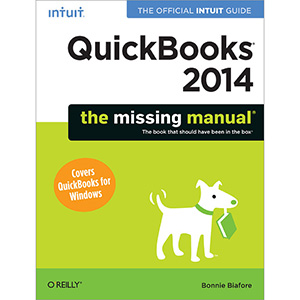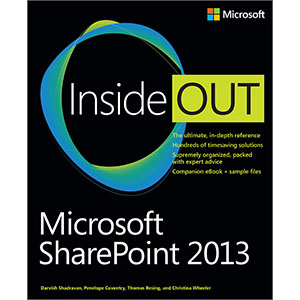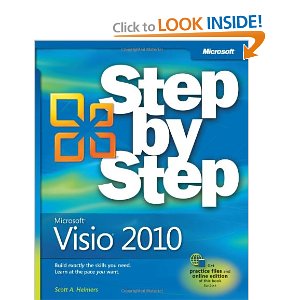Microsoft Project 2010 Inside Out

This book is designed for intermediate to advanced computer users who manage projects. Even if you have never used Microsoft Project 2010 or managed a project before, this book assumes you have experience with Microsoft Windows and at least a couple of programs in Microsoft Office, for example, Microsoft Word, Microsoft Excel, or Microsoft Visio. Depending on where you are along the spectrum of project management experience, this book can help you in the following ways:
- If you are completely new to project management and Project 2010, this book will give you a solid grounding in the use of Project 2010 as well as basic project management practices and methodologies. It will help you understand the phases of project management, including the controlling factors in the project life cycle.
- If you’re an experienced project manager, this book integrates common project management practices with the use of the software tool. This helps you see how you can use Project 2010 to carry out the project management functions you’re accustomed to.
- If you’re already an experienced Microsoft Project user, this book will help you better understand the inner workings of Project 2010 so that you can use it more effectively to do what you need it to do. In many ways, Project 2010 is like an entirely new project management information system. There are several departures from how things were done in previous versions, and there are many more choices to consider which have impact on your project throughout its phases. This book also extensively covers these striking new Project 2010 features, and provides the necessary guidance and “gotchas” regarding whether, when, and how to use those features.
Regardless of your previous experience, this book serves as a facilitator in helping you work with Project 2010 for your project’s processes and phases. Read the chapters and parts you feel are appropriate for your needs right now. Familiarize yourself with the topics available in the other chapters.
Then, as you continue to manage your projects with Project 2010, keep the book within arm’s reach so that you can quickly find the answers to questions and problems as they come up.
As you achieve mastery in one level of knowledge, use this book to help you attain the next level, whether it’s working with multiple projects at one time, customizing Project 2010, or programming Project 2010 functions to automate repetitive activities. This book is your comprehensive Project 2010 reference, in which you can quickly find answers and then get back to work on your project plan.
The book is organized into the following parts:
- Part 1: Project Fundamentals (Chapters 1-2) If you want a primer on project management in general or Project 2010 in particular, read the chapters in this part. Here, you find an overview of Microsoft Project, including what’s new in Project 2010. There’s an overview of project management processes and how Project 2010 facilitates those processes. You also find a discussion of the various kinds of people involved in your project, as well as some keys to successful project management.
- Part 2: Developing the Project Plan (Chapters 3-10) Everything you need to know about starting a new project and creating a new project plan is found here. You get details about working with the Project 2010 workspace, scheduling tasks, setting up resources and assigning them to tasks, establishing costs, and adjusting the project plan to be an accurate model of your project’s reality.
- Part 3: Tracking Progress (Chapters 11-12) After you create the perfect project plan, you’re ready to execute it. To keep the project plan working for you, it needs to be up to date. This part provides details about setting and working with baselines so you can track and compare your progress toward deadlines. It covers important aspects of updating and tracking costs as well as adjusting the schedule, resource workload, and costs to reflect ongoing changes in your project.
- Part 4: Reporting and Analyzing Project Information (Chapters 13-14) Project 2010 provides a wide range of options for setting up and printing views and reports. This part outlines these methods—from simply printing your current view to generating a built-in report to designing and running your own custom report. This part also describes how you can export data to Microsoft Excel or Microsoft Visio to generate visual reports for analysis, as well as how you can use earned value data to analyze progress and costs.
- Part 5: Managing Multiple Projects (Chapters 15-16) As a project manager, it’s likely that you’re managing more than one project at a time, working with a collection of smaller projects that feed into a large project, and working with various groups of resources who contribute to different projects. This part explains the concepts and practices of master projects, subprojects, and resource pools. It also explains how you can exchange information between different project plans; copy or link information; and leverage customized views, reports, groups, and other Project 2010 elements you might have created.
- Part 6: Integrating Project 2010 with Other Programs (Chapters 17-21) Project 2010 is designed to work seamlessly with other programs. You can copy, embed, link, hyperlink, import, and export information. This part describes these methods in detail and also devotes chapters to the specific integration techniques for working with Microsoft Excel, Microsoft Visio, Microsoft Outlook, and Microsoft SharePoint.
- Part 7: Managing Projects Across Your Enterprise (Chapters 22-27) Project 2010 helps to facilitate collaboration in project teams across your enterprise. If you’re using Microsoft Project Professional 2010, Microsoft Project Server 2010, and Microsoft Project Web App, you and your organization have access to robust features for enterprise project management, portfolio management, and team collaboration. In this part, you learn how to set up and use the enterprise features to standardize and customize Project 2010 and project management processes throughout your organization. Project managers and resource managers can assign tasks, obtain task progress updates, and receive status reports from team members. A chapter each is devoted to the duties and capabilities of different stakeholders in the enterprise project management structure: the project server administrator, the project manager, the team member or team lead, the executive or other managing stakeholder, and the portfolio manager.
- Part 8: Customizing and Managing Project Files (Chapters 28-32) With Project 2010, you can create and customize your own views, tables, groups, reports, formulas, macros, and more. You can also customize the Office ribbon. This part covers the details of these custom elements. This part also discusses methods for closing a project at the end of its life cycle and continuing to use what you learn by creating templates that can become the basis for the next project of its kind. Along these lines, this part details project file management issues, including file locations, backups, and multiple versions.
- Part 9: Appendixes This part includes ancillary information you’ll find useful in your work with Project 2010. For example, there are installation guidelines and a list of online resources to expand your knowledge of Project 2010 and project management. Also included is a handy keyboard shortcut reference.
Throughout the book, you’ll find tips that provide shortcuts or alternate methods for doing certain tasks. The Inside Out tips give you information about known issues or idiosyncrasies with Project 2010 and possible methods of working around them.
There are also Troubleshooting tips, which alert you to common problems and how to avoid or recover from them.
This book is designed to be easy to reference so that you can quickly find the answers you need at the time you have the question. The comprehensive table of contents is a good starting point. Another excellent place to start finding your solution is in one of the two indexes at the end of the book. Use the special Troubleshooting index to solve specific problems. Use the master index to help you find the topics you’re looking for when you need them.
Book Details
- Paperback: 1352 pages
- Publisher: Microsoft Press (May2011)
- Language: English
- ISBN-10: 0735626871
- ISBN-13: 978-0735626874














